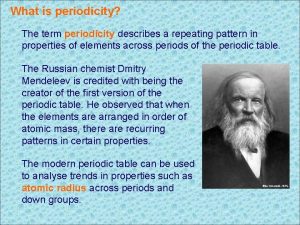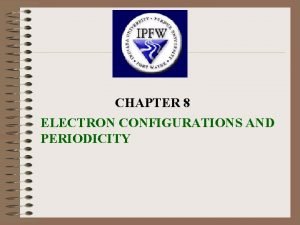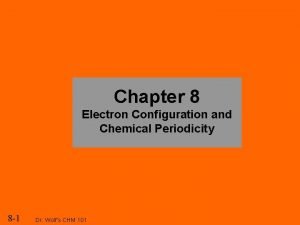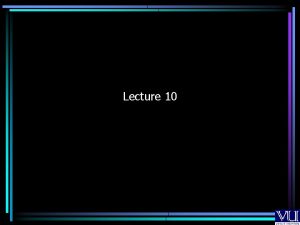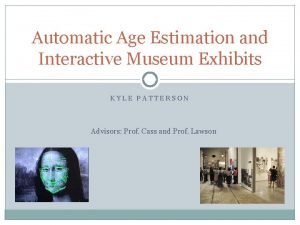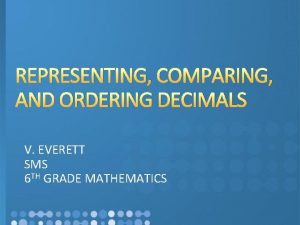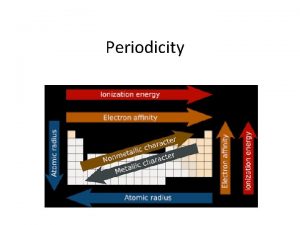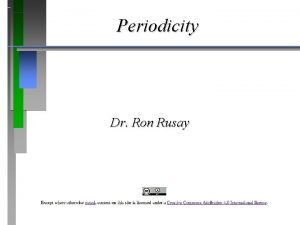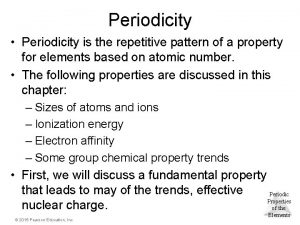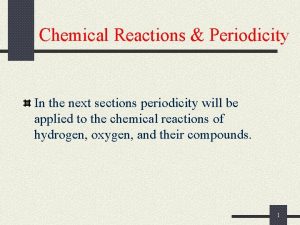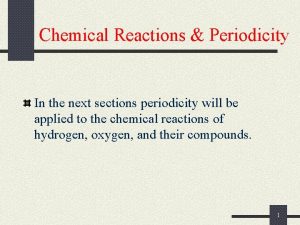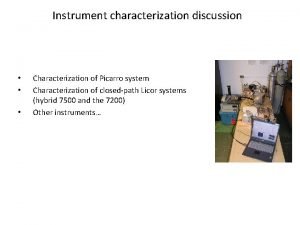Characterization Classification Long range ordering periodicity unit cell

































- Slides: 33

Characterization: Classification: Long range ordering periodicity unit cell Symmetry 7 crystal systems 230 space groups Structural information: Unit cell Miller indices (h, k, l) d spacing Relative intensity atomic positions 1

X-ray Crystallography Introduction Crystal Diffraction Structure · Structure Amplitudes, Fhkl · Atomic scattering factors · Fourier transfer Fhkl (x, y, z) · Least squares refinement · Structure properties --- Distance / angles ; packing etc. · Structure data base 2

Structural Analysis: Data measurement: h, k, l, dhkl , nhkl , Ihkl ( F 2 hkl ) Phase determination heavy atom method; direct method; multiple scattering Fourier transformation: F 2 (r); reciprocal real space Least squares refinement: (r) xi, yi, zi, ui Structural model: bond distances; bond angles; atomic thermal vibration etc. 3

Bragg Diffraction l d 4

Structure Factor Calculation (A)2 (B’)2 F 2 cos 2 F 2 sin 2 F 2 Combination of Wave P 1 f 1 X 1 f 2 P 2 Resultant X 2 0 90 180 f 1 270 Xtotal 0 0 f 2 F A’ i. B’ F ei 90 180 270 Direction (nhkl) Amplitude fi Phase i 360 450 540 Direction (h, k, l) X 1 f 1 cos X 2 f 2 cos Xtotal (f 1 f 2)cos P 1 1 P 2 f 1 2 f 2 0 X 1 90 f 1 X 2 90 180 Phase Resultant 0 0 f 2 F Xtotal 90 180 Xtotal f 1 cos( 1) f 2 cos( 2) cos (f 1 cos 1 f 2 cos 2) Let sin (f 1 sin 1 f 2 sin 2) Xtotal F cos( ) 270 360 450 540 X 1 f 1 cos( 1) Amplitude F hkl F cos F sin B’ f 2 sin 2 f 1 sin 1 f 2 F 2 f 1 1 A’ f 1 sin 1 f 2 sin 2 X 2 f 2 cos( 2) 5

Structure Amplitude (Factor) X 1 S 0 X 2 rn S R Detector 6

Pathlength difference bet. atom n at rn and the origin at 0 Electric field at rn : E 0 : electric field amplitude of the incident beam at rn Electric field at P (defection): 7

2θ 8

mth order Zeroth order ’ E E’ D mth order G a F Incident beam 9

Bh Fh Ah If centrosymmetric and no anomalous scatter: Bh=0; α=0 orπ 10

h 11

Centric case with non-anomalous scatterers Z pt. charge B=0 B>0 atomic sphere (fixed atom at ri) T=0 K with thermal vibration T as function of B : Thermal parameter 12

Centric case with anomalous scatterers when NA : No. of atom types in an asymmetric unit NE : No. of symm. elements of the space group if at (000) Ri : sym. operator h : (h, k, l) xj : (xj, yj, zj) then 13

Considering nuclear thermal vibration As a point scatterer thermal vibration electron density smearing if isotropic spherically symmetric 2 Å 14

Tanisotropic thermal vibration as an ellipsoid 3× 3 matrix 6 elements uij symmetric: u 12= u 21; u 23 = u 32; u 13 = u 31 based on a, b, c, -axis 15

Thermal ellipsoid diagonize eigen value eigen function (three principle axes of the ellipsoid) u 1 u 2 u 3 16

Constraint in Thermal vibration In case of ab-plane mirror plane sym: U 11 , U 22 , U 33 , U 12 U 13=U 23=0 x → x y → y z → -z U 11 U 22 U 33 U 12 U 13 U 23 U 12=U 12 U 13 →-U 13;U 23 →-U 23 ∴U 13=U 23=0 17

Systematic Absences P 21 for any atom i at x y z -x y+1/2 -z R 1 x R 2 x 18

Let hx + lz When 0 i. e. h 0 and I 0 i. e. for 0 k 0 reflections G 0 k 0 cos 2 ky cos 2 [ky (k/2)] i {sin 2 ky sin 2 [ky (k/2)]} cos 2 ky cosk sin 2 ky sink i sin 2 ky cosk i cos 2 ky sink 2(cos 2 ky i sin 2 ky) when k 2 n 0 when k 2 n 1 19

Systematic Absences (space group extinction from translational sym. elements) 20

21

22

23

Atomic Scattering Difference in phase 2 X-ray Beam Atom 24

Atomic Scattering If the atom is a point charge (compared w. r. t the wavelength), it scatters as Z (atomic number) Scattering amplitude (factor) ρ(r) :electron density around nucleus dq = ρ(r) d. V q: charge V : volume amplitude scattered by atom Eatom amplitude scattered by free e- Ee r d 25

26

For example f. Z Int’l Table of X-ray Crystallography. Vol C Ψ mostly from HF p. 477 sinθ/λ Analytical form : Vol C. p 500. 27

f 0 for atoms from Z = 1 to 90 28

coefficients of analytical form in atomic scattering factors 29

30

Anomalous Scattering (b) (a) Gd 30 20 f” 30 Sm 20 f” 10 10 0 0 10 f’ 20 30 Fig. : Anomalous scattering terms f’ and f” for: (a) gadolinium near the L 3 edge; (b) samarium near the L 3 edge 30 1705 1710 1715 184 (Å) (c) f” Gd (d) (Å) 185 f” Sm 30 30 20 20 10 10 Fig. : f’ 30 20 10 0 0 Plot in the complex plane of f’ i f”: (c) gadolinium near the L 3 edge; (d) samarium near the L 3 edge 31

Atomic f’ and f” 32

Relationship between Fhkl & ρuvw Atomic scattering Crystal scattering general form with continuous ρ(u, v, w) Corresponds to the intensity of h, k, l refln. reciprocal space corresponds to the electron density at u, v, w position direction space 33
 As compared to long-range forecasts, short-range forecasts
As compared to long-range forecasts, short-range forecasts Short short short long long long short short short
Short short short long long long short short short In the old days there lived
In the old days there lived What is periodicity
What is periodicity Caries risk assessment form texas medicaid
Caries risk assessment form texas medicaid Cara memakan ikan
Cara memakan ikan Chemsheets periodicity
Chemsheets periodicity Electron configurations and periodicity
Electron configurations and periodicity Electron configuration and chemical periodicity
Electron configuration and chemical periodicity Ap chemistry chapter 7
Ap chemistry chapter 7 Bright futures screening guidelines
Bright futures screening guidelines Oxygen periodic trends
Oxygen periodic trends Atomic radius trend
Atomic radius trend Wuchereria bancrofti
Wuchereria bancrofti Chapter 7 atomic structure and periodicity
Chapter 7 atomic structure and periodicity What is direct characterization
What is direct characterization Indirect and direct characterization
Indirect and direct characterization Contact vs long range force
Contact vs long range force Long range reference service in library
Long range reference service in library Cpc long range forecast
Cpc long range forecast Unit 6 review questions
Unit 6 review questions Classification of material characterization techniques
Classification of material characterization techniques Not so long ago, people
Not so long ago, people Once upon a time there were a king and his queen
Once upon a time there were a king and his queen Tinikling is a bird with long legs and long neck
Tinikling is a bird with long legs and long neck Once upon a time a long long time ago
Once upon a time a long long time ago Long long int c
Long long int c Long long ago when the gods and goddesses
Long long ago when the gods and goddesses Mình tròn thân trắng dáng hình thon thon
Mình tròn thân trắng dáng hình thon thon Once upon a long time ago
Once upon a long time ago Lông vằn lông vện mắt xanh
Lông vằn lông vện mắt xanh Age range classification
Age range classification Define topological sort in data structure
Define topological sort in data structure Representing comparing and ordering decimals
Representing comparing and ordering decimals



